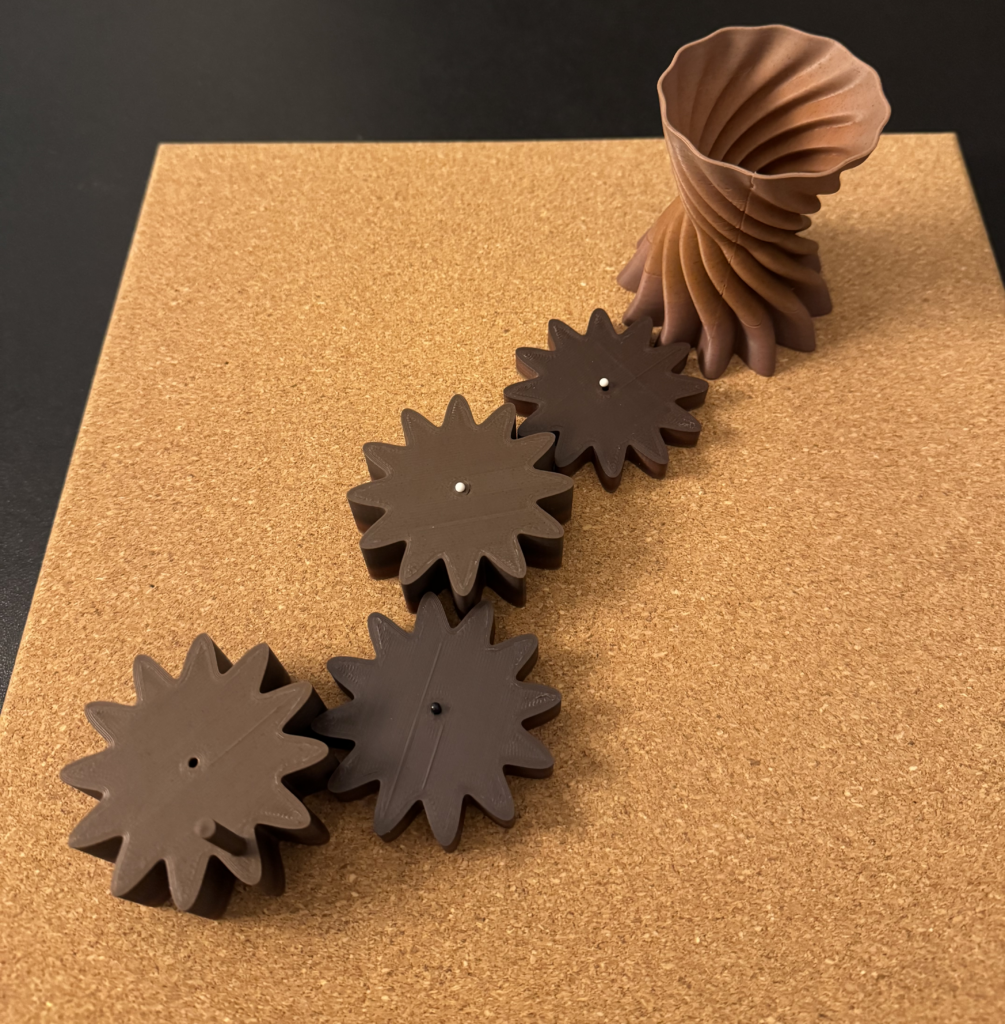Introduction
My primary goal was to explore how organic and geometric forms could transition seamlessly within a single object while also integrating functionality. The base of the vessel was inspired by sine-wave patterns, which served as both a design feature and a mechanism for movement. These sine-wave edges were used to create interlocking gear shapes, capable of transferring motion in a kinetic system. This design allowed the vessel to maintain both visual appeal and structural integrity.



The final design transitions from its sine-wave base into a smooth, circular hourglass-like form, emphasizing fluidity and elegance. The vessel was computationally generated using Python scripts in Grasshopper, where parameters like wave amplitude, frequency, and radius transitions were carefully controlled to achieve a cohesive and dynamic design.
Background Research
To guide my project and provide inspiration for my computationally designed vessel, I explored works that blend computational design, digital fabrication, and functional aesthetics. These examples influenced different aspects of my project, from the sine-wave-inspired base to the structural transitions and kinetic potential.
- Theo Jansen’s Strandbeests
- Theo Jansen’s Strandbeests are kinetic sculptures that move with lifelike fluidity, powered by wind. His use of geometry and mechanical interlocking parts directly influenced my exploration of functional gear components. While my vessel is static, its gear-like base was inspired by Jansen’s ability to create systems that balance artistic and mechanical elements.
- https://www.strandbeest.com
- Michael Hansmeyer’s Computational Architecture
- Michael Hansmeyer is known for using algorithms to create intricate, and detailed architectural forms. His work demonstrated how computational techniques could generate complexity while maintaining control and order. During the prototyping phase, I attempted to incorporate his use of repetition and layered structures into a lattice-style design, though challenges with slicing prevented it from being fabricated successfully.
- https://www.michael-hansmeyer.com
Process
My project began with the concept of creating a functional and visually appealing vessel that incorporated a gear-like base. Using a cork board and sewing pins for alignment, I computationally generated sine-wave patterns in Python and Grasshopper to design the gears. The goal was to create precise, interlocking bases that were also aesthetically pleasing. Through test prints, I experimented with Cura settings, ultimately settling on a 5% infill to balance lightweight construction with durability.



The vessel transitions from its sine-wave base into a circular hourglass form, requiring careful adjustments to parameters like amplitude, frequency, and radius to ensure smooth transitions. During prototyping, I attempted a lattice-style upper structure, but slicing challenges prevented successful prints. By refining my designs iteratively, I was able to resolve issues with watertight geometry and create a functional and visually cohesive final design.



Throughout the process, I faced challenges in creating watertight geometry and ensuring smooth transitions between the base and upper sections. Iterative design adjustments in Grasshopper and Python helped resolve these issues. The final prints came out well, and functioned as intended when placed on the cork board.
Outcome
The final project resulted in a 3D-printed vessel that transitions from a sine-wave-inspired gear base into a circular hourglass shape. Designed to fit within a network of interlocking gears, the vessel can rotate smoothly, enhancing both its functionality and overall aesthetic. The print captured all intended details, balancing structural integrity with lightweight construction. The outcome was successful in my eyes, and shows the potential of computational design to integrate motion, functionality, and aesthetic complexity.

Future Work
If I had more time, I would have liked to experiment with incorporating gears of different sizes, mounted at varying heights and orientations, to create a more dynamic and visually engaging system. This network of interlocking gears could have further emphasized the kinetic potential of the design, transforming the vessel into a centerpiece of motion and interaction. Exploring variations in gear profiles or integrating other geometric transitions could also add layers of complexity and aesthetic depth.
Reflection
This project strengthened my understanding of computational design and digital fabrication, teaching me how to balance functionality, precision, and creativity. Working with sine-wave patterns for functional gear bases highlighted the potential of parametric design to seamlessly integrate motion and aesthetic appeal. Optimizing 3D printing settings, such as infill and wall thickness, was critical for achieving lightweight yet durable prints.